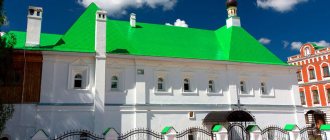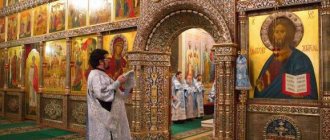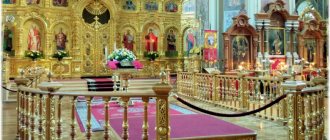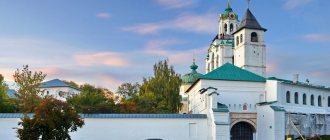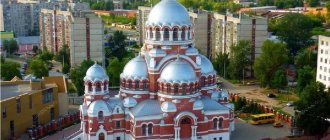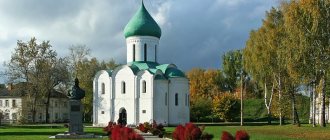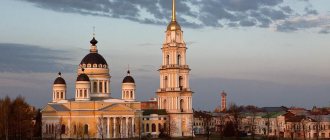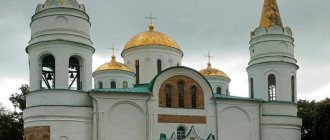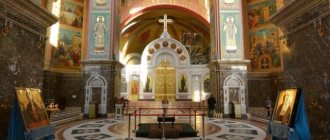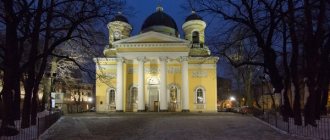Mir
Russia Stavropol Territory Kislovodsk St. Nicholas Cathedral and Spaso-Preobrazhensky Rehabilitation Center (Kislovodsk) Map is loading…
{"format":"leaflet","minzoom":false,"maxzoom":false,"limit":50,"offset":0,"link":"all","sort":[""], "order":[],"headers":"show","mainlabel":"","intro":"","outro":"","searchlabel":"\u2026 \u0441\u043b\u0435\ u0434\u0443\u044e\u0449\u0438\u0435 \u0440\u0435\u0437\u0443\u043b\u044c\u0442\u0430\u0442\u044b","default":"","import-annotation":false,"width ":"auto","height":"350px","centre":{"text":"","title":"""link":"","lat":43.89332999999999884721546550281345844268798828125,"lon": 42.71694000000000102090780274011194705963134765625,"icon":""},"title":"","label":"","icon":"","lines":[],"polygons":[],"circles":[ ],"rectangles":[],"copycoords":false,"static":false,"zoom":8,"defzoom":14,"layers":["OpenStreetMap"],"image layers":[] ,"overlays":[],"resizable":false,"fullscreen":true,"scrollwheelzoom":true,"cluster":false,"clustermaxzoom":9,"clusterzoomonclick":true,"clustermaxradius":80, "clusterspiderfy":true,"geojson":"","clicktarget":"","showtitle":true,"hidenamespace":false,"template":"","userparam":"","activeicon": "","pagelabel":false,"ajaxcoordproperty":"","ajaxquery":"","locations":[{"text":"\u003Cb\u003E\u003Ca href=\"/palomnik/%D0% A1%D0%B2%D1%8F%D1%82%D0%BE-%D0%9D%D0%B8%D0%BA%D0%BE%D0%BB%D1%8C%D1%81%D0%BA %D0%B8%D0%B9_%D1%81%D0%BE%D0%B1%D0%BE%D1%80_%D0%B8_%D0%A1%D0%BF%D0%B0%D1%81%D0 %BE-%D0%9F%D1%80%D0%B5%D0%BE%D0%B1%D1%80%D0%B0%D0%B6%D0%B5%D0%BD%D1%81%D0% BA%D0%B8%D0%B9_%D1%80%D0%B5%D0%B0%D0%B1%D0%B8%D0%BB%D0%B8%D1%82%D0%B0%D1%86% D0%B8%D0%BE%D0%BD%D0%BD%D1%8B%D0%B9_%D1%86%D0%B5%D0%BD%D1%82%D1%80_(%D0%9A%D0 %B8%D1%81%D0%BB%D0%BE%D0%B2%D0%BE%D0%B4%D1%81%D0%BA)\» title=\»\u0421\u0432\u044f\u0442\ u043e-\u041d\u0438\u043a\u043e\u043b\u044c\u0441\u043a\u0438\u0439 \u0441\u043e\u0431\u043e\u0440 \u0438 \u0421\u043f\u0430\ u0441\u043e-\u041f\u0440\ u0435\u043e\u0431\u0440\u0430\u0436\u0435\u043d\u0441\u043a\u0438\u0439 \u0440\u0435\u0430\u0431\u0438\u043b\u0438\u0442\u04 30\u0446\u0438\u043e\u043d\ u043d\u044b\u0439 \u0446\u0435\u043d\u0442\u0440 (\u041a\u0438\u0441\u043b\u043e\u0432\u043e\u0434\u0441\u043a)\»\u003E\u0421 \u0432\u044f\u0442\ u043e-\u041d\u0438\u043a\u043e\u043b\u044c\u0441\u043a\u0438\u0439 \u0441\u043e\u0431\u043e\u0440 \u0438 \u0421\u043f\u0430\ u0441\u043e-\u041f\u0440\ u0435\u043e\u0431\u0440\u0430\u0436\u0435\u043d\u0441\u043a\u0438\u0439 \u0440\u0435\u0430\u0431\u0438\u043b\u0438\u0442\u04 30\u0446\u0438\u043e\u043d\ u043d\u044b\u0439 \u0446\u0435\u043d\u0442\u0440 (\u041a\u0438\u0441\u043b\u043e\u0432\u043e\u0434\u0441\u043a)\u003C/a\u003E \u003C/b\u003E\ u003Chr /\u003E\u003Ca href=\»/palomnik/%D0%A1%D0%B2%D0%BE%D0%B9%D1%81%D1%82%D0%B2%D0%BE:%D0%90 %D0%BD%D0%BD%D0%BE%D1%82%D0%B0%D1%86%D0%B8%D1%8F\" title=\"\u0421\u0432\u043e\u0439\u0441\u0442 \u0432\u043e:\u0410\u043d\u043d\u043e\u0442\u0430\u0446\u0438\u044f\»\u003E\u0410\u043d\u043d\u043e\u0442\u0430\u0446\u0438 \u044f\u003C/a\ u003E: "\u0421\u0432\u044f\u0442\u043e-\u041d\u0438\u043a\u043e\u043b\u044c\u0441\u043a\u0438\u0439 \u0441\u043e\u0431\u043 e\u0440"' \u2014\ u043a\u0430\u0444\u0435\u0434\u0440\u0430\u043b\u044c\u043d\u044b\u0439 \u0441\u043e\u0431\u043e\u0440 \u0432 \u041a\u0438\u 0441\u043b\u043e\u0432\u043e\ u0434\u0441\u043a\u0435, \u0433\u043b\u0430\u0432\u043d\u044b\u0439 \u0445\u0440\u0430\u043c \u041a\u0438\u0441\u043b\u043e\ u0432\u043e\u0434\u0441\u043a \u043e\u0433\u043e \u0431\u043b\u0430\u0433\u043e\u0447\u0438\u043d\u0438\u044f. \u0420\u0430\u0441\u043f\u043e\u043b\u043e\u0436\u0435\u043d \u0441\u043e\u0431\u043e\u0440 \u043d\u0430 \u043f\u0440\u043e \u0441\u043f\u0435\u043a\u0442 \u0435 \u041c\u0438\u0440\u0430. 2009 2009 \u0441\u044f \u043f\u0435\u0440\ u0432\u044b\u0439 \u0436\u0435\u043d\u0441\u043a\u0438\u0439 \u0444\u0438\u043b\u0438\u0430\u043b \u0421\u043f\u0430\u0441\u 043e-\u041f\u0440\u0435\u043e \u0431\u0440\u0430\u0436\u0435\u043d\u0441\u043a\u043e\u0433\u043e\u0440\u0435\u0430\u0431\u0438\u043b\u0438\u0442\u0430\u 0446\u0438\u043e\u043d\u043d \u043e\u0433\u043e \u0446\u0435\u043d\u0442\u0440\u0430.","title":"\u0421\u0432\u044f\u0442\u043e-\u041d\u0438\u043a\u043e\u043b \u044c\ u0441\u043a\u0438\u0439 \u0441\u043e\u0431\u043e\u0440 \u0438 \u0421\u043f\u0430\u0441\u043e-\u041f\u0440\u0435\u043e\u0431\ u0440\u0430\u0436\u0435\u043d \u0441\u043a\u0438\u0439 \u0440\u0435\u0430\u0431\u0438\u043b\u0438\u0442\u0430\u0446\u0438\u043e\u043d\u043d\u044b\u0439 u0446\u0435\u043d\u0442\u0440 (\u041a\u0438\u0441\u043b\u043e\u0432\u043e\u0434\u0441\u043a)","link":"","lat":43.89332999999999884721546550281345844268798828125, "lon":42.71694000000000102090780274011194705963134765625,"icon":""} ],"imageLayers":[]}
43.89571; 42.714937
Russia, Stavropol Territory, Kislovodsk, Mira Avenue
Kislovodsk, Stavropol region
Russia
Telephone:
+7 (87937) 3-11-92, fax: +7 (87937) 3-02-37
St. Nicholas Cathedral
- Cathedral in Kislovodsk, the main temple of the Kislovodsk deanery. The cathedral is located on Mira Avenue. In 2009, the first women's branch of the Spaso-Preobrazhensky Rehabilitation Center appeared at the temple.
History[edit]
The first temple dedicated to St. Nicholas the Wonderworker appeared in Kislovodsk back in 1803. It was a wooden church on the territory of the fortress. The stone St. Nicholas Cathedral was built in 1883-1888. In 1900, a five-tier bell tower was built next to the church. Under Soviet rule, the building was blown up on September 1, 1936.
On March 28, 1991, St. Nicholas parish was recreated. In the building returned to the Church, a temple was rebuilt in the name of St. Nicholas the Wonderworker, which again became the center of the spiritual life of the city. Since August 14, 1991, regular services were held in the house St. Nicholas Church, and a Sunday school began operating.
Meanwhile, on April 14, 1991, in the city square, on the site of the destroyed cathedral, a cross was erected with an inscription about the upcoming reconstruction of the destroyed temple. Work to prepare for construction took two years. The cathedral project was developed by a group of designers led by architect V. B. Svintsitsky. Photographs of the old cathedral were used as the basis for the project.
On September 12, 1993, with a gathering of thousands of believers, the first stone was laid at the site of the restoration of the cathedral. A prayer service with the rite for the foundation of the cathedral was performed by Metropolitan Gideon of Stavropol and Bishop Athanasius of Perm, co-served by a large host of clergy. Representatives of the administration, Cossacks, Armenian and Georgian communities of the city took part in the service; Patriarch of Moscow and All Rus' Alexy conveyed a blessing in his message. To commemorate this event, a wooden cross, consecrated in 1998, was re-installed on Krestovaya Hill in the city.
Kislovodsk St. Nicholas Cathedral. The photo is no earlier than the 1930s.
Under the administration of Caucasian Mineral Waters, on August 19, 1994, a Board of Trustees was created to ensure the support and development of the Russian Orthodox Church in the region. The Chairman of the Board of Trustees, the head of the administration of Caucasian Mineral Waters, Alexei Viktorovich Kulakovsky, found funds for the construction of the cathedral and called on the leadership of resort cities to participate in the revival of Orthodox churches. By decision of the head of the city of Kislovodsk, V. G. Beketov, taxes were removed from the work performed. The association of heating networks laid 23 m of heating mains free of charge. The above-ground part was erected by the builders of SMU-17. However, in 1996 construction work began to slow down. Due to a lack of funds, initial plans to complete the work by 1998 had to be changed. Despite the fact that federal funding was stopped, construction did not stop.
On May 20, 1997, three large icons on copper plates using the enamel technique were installed on the facades of the temple, corresponding to the three altars of the cathedral: St. Nicholas the Wonderworker, Blessed Grand Duke Alexander Nevsky and St. Alexy, Metropolitan of Moscow. The election of the saints in whose name the chapels were consecrated was due to the fact that they are the heavenly patrons of the patriarch and metropolitan, who contributed to the revival of the cathedral [9]. On the day of the patronal feast of May 22, 1997, for the first time since the beginning of the revival, the rector of the church, Archpriest John of Znamensky, performed a festive Divine Liturgy, followed by a crowded religious procession. On November 25, three large bells were consecrated and installed on the belfry, and on December 29 of the same year, the restored temple was crowned with the first dome. In 1999, on February 7, the first Divine Liturgy was celebrated in the lower church of the cathedral, consecrated in the name of the new martyrs and confessors of Russia. On February 25, Thursday of the first week of Lent, the main dome with a cross was erected on the temple; on May 22 of the same year, for the first time, City Day was timed to coincide with the patronal feast of the cathedral. Regular services in the upper church began on Easter 2000.
The construction of the cathedral fence was completed with the erection of the dome on the main gate on July 21, 2002. During the Great Lent of 2005, a team of artists under the leadership of N. M. Vdovkin completed the installation of the altar canopy, and at the beginning of 2006 Vdovkin began work on painting the altar. On December 3, 2006, the laying of granite floors was completed. In December 2007, the painting of the altar was completed and the solea fence of all three altars was installed. After the Nativity of Christ in 2008, painting of the under-dome part began.
On May 22, 2008, the great consecration of the cathedral took place. The rite was performed by Metropolitan Clement of Kaluga and Archbishop Feofan of Stavropol with a host of clergy in front of a gathering of thousands of believers. Patriarch of Moscow and All Rus' Alexy II sent a message to the participants of the celebrations.
Schedule of services
Morning and evening services are held daily in the Cathedral of St. Nicholas the Wonderworker:
- Liturgy - at 07:30 (weekdays), at 06:00 and 09:00 (Sunday);
- Evening service - at 17:00.
Every Tuesday at 15:00 prayers are held for the successful resolution of childbirth and the successful course of pregnancy. Every week on Saturdays at 15:00, prayers with an akathist to the Most Holy Theotokos are held in front of the “Inexhaustible Chalice” icon. On Wednesdays, the evening service is supplemented by an akathist to St. Nicholas the Wonderworker.
Central iconostasis and chandelier, © Vladimir Emelyanov
Schedule of services in St. Nicholas Cathedral in Kislovodsk
Description[edit]
In the revived St. Nicholas Cathedral, the three-apse cruciform five-domed plan with helmet-shaped domes and arched facades was preserved from its predecessor temple. The architecture of the cathedral has many unusual features. The meter thick walls are due to the large height of the building. To increase the load-bearing capacity, there is brickwork along the edges, and monolithic reinforced concrete inside. The central dome rests not on four columns as usual, but on semi-arched structures, which made it possible to increase the area of the hall. Three hanging balconies rest on 14-meter beams, which are both railings and floor supports. The foundation of the building is a monolithic reinforced concrete slab supported on piles. The total weight of the cathedral is 18 thousand tons. The height is 54 meters, commensurate with the surrounding high-rise buildings. The cathedral is designed to accommodate 3.5 thousand people.
History of temples in the name of St. Nicholas the Wonderworker
The first mention of the St. Nicholas Church on Kislye Vody dates back to 1803. It is known that a long one-story building was erected from wood within the boundaries of the Kislovodsk fortress. There were no decorations outside or inside, only in the middle of the gable plank roof there was a tent topped with a cross. Divine services were then conducted by a single priest on holidays and Sundays, and the church choir consisted of soldiers.
The fame of the healing mineral spring Narzan quickly spread beyond the Caucasus. Year after year, more and more holidaymakers came here, so the need to build new houses around the fortress arose on its own. In addition, retired soldiers did not want to go home, considering this region their second homeland. Kislovodskaya Sloboda was growing, but entry to the garrison church was limited. In such a situation, the only solution was to build a new temple for local residents and visitors.
Night illumination, © Dmitry89
Parish Nicholas Church
In 1824, the Bernardazzi brothers, natives of Italian Switzerland, began designing a new Orthodox building. A few years earlier, they came to St. Petersburg to participate in the construction of St. Isaac's Cathedral. Soon Joseph Karlovich and Johann Karlovich found themselves in the Caucasus, and subsequently became the first architects of Kislovodsk and Pyatigorsk. General A. Ermolov, who in those years held the position of Commander-in-Chief of the North Caucasus Troops, approached Bernardazzi with a request to take up the project.
A new wooden church in the name of St. Nicholas the Wonderworker was built on the elevated bank of the Olkhovka River in the period 1825–27.
A special feature of the St. Nicholas Church was the absence of metal fasteners in the structure. At that time, nails and staples were not produced in the Caucasus, and it was too expensive to import them from afar. Therefore, it was necessary to assemble the crowns and roof with the help of axes and saws.
Bird's eye view of the main cathedral of Kislovodsk, © Muhammad Ortikov
In plan, the building had the shape of a cross, elongated towards the west. The inner surface of the walls was painted with white, which has a bluish tint. The decoration of the church consisted of a three-tiered iconostasis with gilded carvings, decorated with lush floral ornaments, and several small icons in frames hung on the walls. Wide window openings served as light sources during the daytime. In the evenings, candles were lit in the temple, placed in the chandelier and numerous lamps.
The facades of the wooden St. Nicholas Church, considered the adornment of the entire Kislovodsk settlement, were decorated with lace carvings. The central dome was an octagonal tent topped with a cross. The bell tower had a similar roof structure, but was smaller.
Stone Temple
The urgent need to expand the church appeared in the second half of the 19th century. The population of Kislovodsk grew, so the old temple could no longer accommodate everyone. Divine services were held in cramped conditions, some even had to stay on the street. Petitions for the construction of a new stone structure have been submitted to the highest religious authorities more than once since 1879. They were accompanied by plans and approximate estimates. Permission was received in 1883.
St. Nicholas Cathedral against the background of surrounding landscapes, © anderson2706
It is believed that the author of the project is the architect V. Grozmani. The construction was supervised by military engineer V. Afinogenov.
- The period of construction of the temple was 1883–88.
- Consecration of the white stone St. Nicholas Church - November 4, 1888
- Construction of a five-tier bell tower - 1900
- Obtaining the status of a cathedral - 1908.
- Closing in the early 1930s.
- Destruction - September 1, 1936
The stone three-altar St. Nicholas Cathedral had impressive dimensions, but outwardly it did not look like a heavy block. Several styles were present in its architectural appearance, but in general harmony was maintained with the resort development. The interior decoration consisted of three carved iconostases made of wood and covered with gilding, rich paintings created by famous Russian masters of that time, gilded vestibules over the altars and the altar, as well as various church utensils.
Parishioners of St. Nicholas Cathedral had the opportunity to hear the voices of the great Russian singers M. Sobinov and F. Chaliapin.
Near the church, a Cathedral Square and a necropolis appeared, where many respected citizens and prominent clergy were buried. After the temple was razed to the ground in the 30s of the last century, a square was laid out in its place, in the center of which a monument to V. Lenin was erected. The square was renamed Red Square.
View of the cathedral from Mira Avenue, © Anna Kudryavtseva
Social service[edit]
Working with drug addicts[edit]
In 2009, with the blessing of Bishop Theophan, Archbishop of Stavropol and Nevinomyssk, on the territory of the KMS, in Kislovodsk, at the Church of St. Nicholas, the first women's branch of the Spaso-Preobrazhensky Rehabilitation Center appeared.
Within the walls of the center, work is being carried out on the rehabilitation and prevention of addictions from drug addiction, alcoholism, gambling addiction, the resocialization of people, and the revival of their spiritual values.
The main stages of work: getting rid of the disease of drug addiction; spiritual and moral revival of the individual, revival of spiritual values; churching.
The center's students carry out preventive activities for young people, social events, and pickets aimed at preventing and stopping the development of drug addiction and alcoholism.
During the existence of the Orthodox women's rehabilitation center, 26 women of different ages underwent rehabilitation, more than half of whom returned to society as useful people. One of the pupils remained to work at the center, and 8 returned to normal life and started families. The branch in the city of Kislovodsk is designed for simultaneous accommodation of 10 novices. Currently, 6 people are undergoing rehabilitation.
The novices of the women's center struggle with their dangerous addictions by serving God and others, join the church, lead a socially useful lifestyle with the hope of returning to society as full-fledged citizens. Obedience in the temple is a task that each of the nuns performs with special care. The evening and morning rules are always performed in the center, the Bible and the Lives of the Holy Fathers of the Orthodox Church are studied. The girls also conduct preventive conversations with those who have decided to take the path of repentance and correction.
Cathedral architecture
The architectural appearance of the cathedral contains features of several styles of church architecture, while it is in perfect harmony with the surrounding urban development and mountain landscape.
The revived St. Nicholas Cathedral inherits all the main features of its predecessor temple with the exception of the bell tower. In plan, its tall building has the same cruciform shape, which is complemented by three protruding apses of the altar.
The main volume of the temple is completed by five helmet-shaped domes, which are mounted on high light drums, shaped like lanterns. The largest and highest of them is the central one, two pairs of corner heads are lower and smaller in diameter. Two of them house bell towers. The domes of the five-domed building are topped with crosses of the same size.
The facades of St. Nicholas Cathedral are characterized by an arched shape: it is this that gives the building a certain lightness and visual aspiration upward, towards the heavens. This impression is reinforced by some horizontal elements of the cathedral's architecture, and especially the semi-circular windows.
The 10th anniversary of the consecration of St. Nicholas Cathedral was celebrated in Kislovodsk
Published 23.05.2018 13:55 |
Rating: / 2
On May 22, 2022, on the day of the transfer of the holy relics of St. Nicholas the Wonderworker, the memory of the heavenly patron of the temple and the Orthodox gymnasium was honored in Kislovodsk.
The celebrations began in St. Nicholas Cathedral, where a prayer service and a festive Divine Liturgy were performed. The service was led by the rector of the cathedral, Archpriest John of Znamensky.
On the 10th anniversary of the consecration of the cathedral, regular parishioners of the temple, guests of the resort city, teachers and students of the Orthodox St. Nicholas Classical Gymnasium gathered to honor the memory of St. Nicholas on the 10th anniversary of the consecration of the cathedral.
The chants of the Divine Liturgy were performed by the high school students celebrating the day of the school's patron saint and the cathedral choir. All students received Holy Communion.
After reading the Gospel, Father John conveyed the blessing of His Eminence Theophylact, Archbishop of Pyatigorsk and Circassia, congratulated everyone on the patronal holiday and addressed those present with a sermon, in which he drew attention to the ascetic life of the Saint, to the example of firm faith that we need in everyday life. called on everyone to keep the grace of God in their hearts and imitate St. Nicholas in love for God and neighbor. At the end of the Divine Liturgy, a traditional religious procession took place
Father John, having sprinkled holy water on the participants of the festive procession, once again congratulated everyone on the holiday and invited them to the cathedral square, where the guests were able to taste dishes prepared in the field kitchen organized by the Kislovodsk Cossacks. Over fragrant tea and pies, everyone could chat and rejoice at the temple’s anniversary
At the end of the Divine Liturgy, a traditional religious procession took place. Father John, having sprinkled holy water on the participants of the festive procession, once again congratulated everyone on the holiday and invited them to the cathedral square, where the guests were able to taste dishes prepared in the field kitchen organized by the Kislovodsk Cossacks. Over fragrant tea and pies, everyone could chat and rejoice at the temple’s anniversary.
The holiday continued at the evening service with the singing of an akathist to St. Nicholas the Wonderworker. The clergy of the Kislovodsk church district arrived to glorify the great saint and congratulate the rector on the anniversary patronal holiday. The confessor of the deanery, Archpriest Hermogen Limanov, on behalf of the clergy, congratulated Archpriest John on the patronal celebration, noting his contribution to the restoration of the cathedral.
In conclusion, Father John thanked Archbishop Theophylact for his attention and Archpastoral instructions, his brothers for the conciliar prayer, and the benefactors and trustees of the church for their constant care and material assistance to the parish. At the end of the service, all those praying in the temple were anointed with blessed oil, sprinkled with holy water and received as a gift the image of the patron of the temple
At the end of the service, all those praying in the temple were anointed with consecrated oil, sprinkled with holy water and received as a gift the image of the patron of the temple.
Save us, as our representative, great Nicholas!
Forward >
Necropolis
| Burial place of the Patriarchs of Constantinople. Istanbul. Balykly. Monastery of the Icon of Our Lady “Life-Giving Spring” |
The monastery of the Life-Giving Source contains the burial places of the Patriarchs of Constantinople [25]
- Anthimus V (Chrysafidis) (+ 1842)
- Meletius III (Pankalos) (+ 1845)
- Hermann IV (+ 1853)
- Constantius I the Wise (+ 1859)
- Joachim II (Kokkodis) (+ 1878)
- Dionysius V (Charitonidis) (+ 1891)
- Joachim III (Devedzis) (+ 1912)
- Anfim VII (Tsatsos) (+ 1914)
- Gregory VII (Zervoudakis) (+ 1924)
- Constantine VI (Arapoglou) (+ 1925)
- Basil III (Georgiadis) (+ 1929)
- Photius II (Maniatis) (+ 1935)
- Benjamin I (Psomas) (+ 1946)
- Maxim V (Vaportzis) (+ 1972)
- Athenagoras I (Spirou) (+ 1972)
- Demetrius I (Papadopoulos) (+ 1991)
Architect, exterior decoration, architectural ensemble
Reconstruction of the modern cathedral began in 1993. The project of the new temple was developed by the architect V.B. Svintsitsky. Work on the creation of the project lasted for more than two years. The basis was taken from photographs of an old building destroyed by the Bolsheviks in the 30s.
The main task of the designers and builders was to accurately recreate the appearance of the former temple, and they coped with this. The structure retained its cruciform shape; three semicircular projections (apses) were attached to the sides. The facades of the cathedral are made in an arched form.
Three of them have large icons; they are painted in enamel on copper sheets. The icons correspond to the three thrones of the temple: Alexander Nevsky, Nicholas the Wonderworker, Metropolitan of Moscow St. Alexy.
The entire majestic composition of the cathedral was crowned with five domes. The middle dome was designed to be the tallest and largest in diameter. The final height of the structure was 54m, and the total weight of the entire structure was 18,000t. On major church holidays, the temple can accommodate up to 3,500 parishioners.
St. Nicholas Cathedral in Kislovodsk after the revolution
After the revolution, St. Nicholas Cathedral in Kislovodsk survived and remained active. For almost 15 years, services were held there, which gradually lost their regularity. This continued until 1936, when the authorities decided to erase this temple from the face of the earth.
St. Nicholas Church in Kislovodsk was blown up in early September 1936 by order of the Soviet administration. The beautiful temple was destroyed by a powerful explosion, to the great sadness of the Orthodox residents of Kislovodsk.
The history of the restoration and new life of St. Nicholas Cathedral begins with the collapse of the Soviet Union, positive changes in society in relation to Orthodoxy and the process of rebuilding St. Nicholas parish. The starting point of this good action is considered to be March 27, 1991. The church was given back the territory of the cathedral and the original brick building for the parish, which previously, in Soviet times, housed the city's Main Post Office.
It was decided to rebuild the temple in the name of St. Nicholas the Wonderworker. Archaeological excavations were carried out to determine the historical boundaries of the temple. It was decided to restore the cathedral to its former appearance, for which they undertook a search for old photographs in the Kislovodsk and federal archives. We managed to find several pre-revolutionary photographs, the images on which were taken as the basis when forming the project.
Inside the cathedral
The interior decoration of the St. Nicholas Cathedral in Kislovodsk has always made a great impression; its floors are lined with granite slabs; the temple can accommodate 3,500 pilgrims. This is facilitated by its internal design: the central dome of the temple rests not on four pillars, as can often be seen in other Orthodox churches, but on specially designed structures in the form of semi-arches.
The premises of the cathedral create excellent acoustics, for which the previous temple was famous. It is no coincidence that at one time, under the arches of the St. Nicholas Church, the voices of the great Russian vocal masters - Fyodor Chaliapin and Leonid Sobinov, were heard, singing along with the church choir of the cathedral.
Nowadays in the St. Nicholas Cathedral all three chapels are painted, and in the side chapels you can see paintings of scenes from the lives of the saints in whose honor they were consecrated. This, for example, is the foundation of the Moscow saint, Metropolitan Alexy Chudov monastery or the vision of the holy prince Alexander Nevsky of the passion-bearing princes Boris and Gleb on the eve of the historical battle with the Swedes.
The most revered icons of St. Nicholas Cathedral are located on both sides of the main iconostasis and placed in gilded icon cases. The baroque iconostasis in the pseudo-Russian style was created in 2010. The entire structure consists of four tiers and is also richly decorated with gilded openwork details, surrounded by a fine ligature of skillful wooden carvings that make up various ornaments in folklore traditions.
In each of the aisles there are two-tiered iconostases of similar shape. Solei are traditionally separated from other areas of the interior of the temple by decorative fences made of beautiful and graceful openwork lattices.
